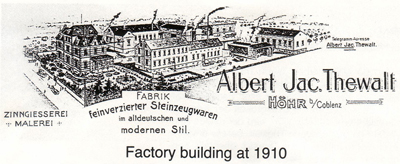
Stoneware Beer Stein Factory,
Hoehr-Grenzhausen in the Westerwald Region of Germany

COMPANY INFORMATION (provided by Albert Thewalt)
The THEWALT COMPANY has a long history.
When the founder, Albert Jac.Thewalt started in 1893 with his own stoneware factory, he could glance backward at a long family tradition, as his father and his grandfather also were potters and beerstein-makers since 1781. - His grandson with the same name today manages the company.
In 1897 he employed the famous modeller Wilhelm Kamp, who designed nearly 800 steins until 1914, which to a great extent still today are in production within the series "Traditional Old German Steins". See page 2. The designs on these steins mostly are based on the paintings of the famous Tyrolese artist Franz von Defregger, 1835 - 1921.
After World War II beer steins had an unexpected, stormy renaissance. New molds, new shapes and new motifs, designed by Cesare Cardinale, were created and produced on high-quality technical equipment, but still in the good old German tradition.
Today 15 craftspeople are employed within the Thewalt Stein Company, producing over 75,000 pieces per annum for collectors and individualists all over the world, for gift-purposes and for beerstein-lovers in an excellent quality. Handcraftsmanship is still the secret of success. - Simply to be better, that's the device of our company.
Thewalt's selection of German Beer Steins Include: Specialty Steins, Souvenir Steins, Old German Steins (Traditional Steins), Gift items, Custom Steins and many more!!
Addendum: Sadly, in October of 2009, Thewalt ceased production. In 2011 the rights to faithfully manufacture selected steins from the original molds were sold to King-Werk GmbH. These steins are marked "Thewalt 1893" on the base. Browse the Thewalt 1893 steins we carry
FIRMEN-INFORMATION
Die Firma THEWALT GmbH hat eine lange Geschichte.
Als Albert Jac. Thewalt 1893 seine eigene Steinzeugfabrik gründete, konnte er auf eine lange Familientradition zurückblicken, denn schon sein Vater und sein Großvater waren Töpfer - seit 1781. - Sein Enkel - gleichen Namens - führt heute das Unternehmen.
Wilhelm Kamp, ein begnadeter Modelleur, trat 1897 in das Unternehmen ein und schuf bis 1914 etwa 800 Modelle, die großenteils heute noch produziert werden innerhalb der Serie "Traditionelle Alt-Deutsche Bierkrüge" - siehe auch Seite 2. - Die Motive sind hauptsächlich gestaltet nach den Gemälden des berühmten Tiroler Malers Franz von Defregger, 1835 - 1921.
Nach dem 2. Weltkrieg erlebte der altdeutsche Bierkrug unerwartet eine stürmische Renaissance. Neue Modelle, neue Formen und neue Motive wurden geschaffen, modelliert von Cesare Cardinale, und mit moderner Technik produziert, doch stets unter Wahrung guter, altdeutscher Tradition.
Z.Zt. produzieren 15 Facharbeiter über 75.000 Bierkrüge pro Jahr für Sammler und Individualisten in der ganzen Welt, zu Geschenkzwecken, als Liebhaberei oder auch für den praktischen Gebrauch, in exzellenter Qualität. Solide handwerkliche Arbeit ist das Geheimnis unseres Erfolgs.
"EINFACH BESSER ZU SEIN", die Devise unseres Unternehmens.


A not-quite-everyday reflection!
from Thewalt GmbH
~German Beer Stein Manfacturer~
A beer stein is:
~ a drinking receptacle,
~ a souvenir from Old Germany
~ a knickknack
~ a collector's piece
~ a kitsch item
~ an investment
~ an expression of gemuetlichkeit
~ a Bavarian status symbol
Beer steins are popular in Germany, America, Japan, Russia and practically in all other countries as a thoroughly German original product.
What is the reason behind the fascination exercised by a product whose practical value has long been replaced by beer glasses?
Is it its German origin? The world is not very particular about that any more!
Is it its colorful appearance? That can be enjoyed in many other objects too!
Is it its lid? Perhaps as a practical cover to keep off the flies?
No, there must be other reasons.... Such as:
* Because it's imposing and manly. But so were the drinking horns out of which the ancient Teutons lapped up their mead - a hooch which was neither beer nor wine.
*Because a beer stein is just right to bang on the table (or possibly on your opponent's head) without the unpleasant accompaniment of glass splinters.
*Because beer and beer steins belong together as if by wedlock.
*Because beer is a special beverage which has its own image and thus deserves its own receptacle.
Can you imagine drinking beer from a wine glass or wine from a beer stein? The idea is absurd, although -how ghastly!- the plastic cup has now become acceptable for both drinks.
But there must be something else which gives the beer stein its timeless appeal...
Just a second, I think I have it! Yes, that's it: A beer stein has a soul!
You cannot hear it or taste it or see it or feel it - but it's there.
And, as the renowned pathologist Virchow said, souls cannot be dissected. Nor can they be explained by the cool, rational thinking of Homo sapiens. Above all, they are immortal - and that seems to be the core of the whole matter.
Thus - in spite of croakers and prophets of evil - the beer stein will live on. Unfortunately nobody knows who invented it but, whoever it was, he deserves a monument!
~ Albert J. Thewalt GmbH






